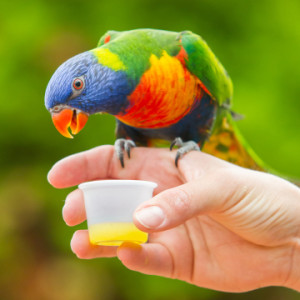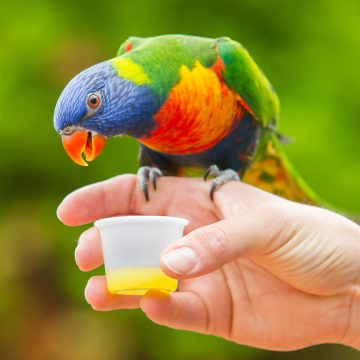
Australian Rainbow Lorikeet, Trichoglossus moluccanus, on a human hand
Parrot training is relatively easy when you know the “secrets” they expect in return and teaching tricks to your parrot will lead to good behavior.
You know, it seems everyone who sees a parrot wants to get it to talk. Some parrots are more talkative than others but, of course, it will depend on the species of parrot. Beyond that just Parrots require a lot of attention and interaction so the more time you spend interacting and teaching the better. But who doesn’t want a parrot to do parlor tricks at your next get together? So here’s how to train our parrot to do tricks (even talking if that’s something the species has a propensity for).
First, keep in mind that positive rewards are key when it comes to parrot training.
Praise is great, but Polly really does want a cracker. So when you’re trying to train your parrot make sure you have plenty of treats on hand. When you get an undesired reaction out of your parrot just ignore it. Parrots often are about as smart as a 2 year old, so think of it like you would a child. Sometimes negative attention is better than no attention so you don’t want to get your parrot into that mindset. Once you are prepared with your positive reward you can follow these steps to train your parrot.
1. Work with your parrot when you’re in a good mood. This will make it easier to provide the positive award and not snap at your parrot.
2. Consider your parrots mood as well. If it’s time to eat or a time he usually likes to sleep, then you’re probably not going to get the desired behavior out of him.
3. Short and sweet training sessions are great, but do it a lot and consistently. Attention span will likely be much like a 2 year old.
4. Once he begins to get the trick start switching your reward to praise instead of what you used to get the desired reaction. This way there won’t be that expectation every time he does it and you are more likely to get him to do the trick sporadically.
5. Always end on a high note. If you get the desired reaction or something that’s close enough, then it’s a good time to end for the day and move onto something else.
6. Keep training sessions upbeat and fun. You don’t want it to be a chore.
7. Teaching your parrot to step up on your your finger or porch and step down on command is a great way to start training your parrot. It’s simple and stepping up is something very natural for a bird. Step down might be a little harder to teach, but it’s a good thing to start out teaching.
If you keep these seven parrot training tips in mind, you should have no problem achieving the desired results. Just remember, know your parrot’s limits and capabilities. Start small and work up with plenty of positive reinforcement and you’ll have your parrot doing tricks before you know it.
[xyz-ihs snippet=”Signoff1″]

